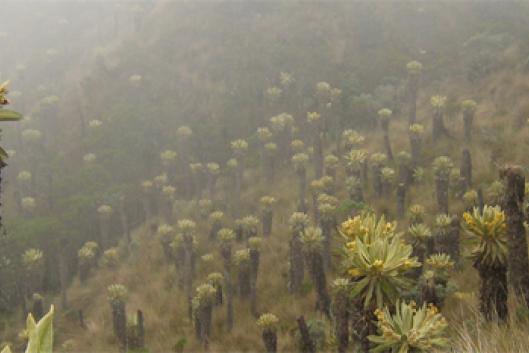Meekly the water flows from lichens and stones
like a flood of feelings from
the soul of the earth...
(Efraín Gutiérrez Zambrano)
Páramos are life systems of the high Andean mountains of countries like Ecuador, Peru, Venezuela and Colombia. Colombia is home to more than half the páramos of the planet. The landscape of páramos in Colombia commonly consists of reed beds, frailejón (Espeletia) species, rosemary, dwarf trees, swirling mist, farm crops, livestock and warmly-wrapped, red-cheeked peasants.
Colombians are aware of the importance of the páramos since they provide about 70 per cent of the water needs of the population. The ecological conditions in páramos are such that a large number of major rivers rise there, including the Cauca, the Magdalena and the Meta.
Historically, human beings have influenced and transformed the páramos. It has been home for thousands of years to many communities that have developed cultural characteristics and forms of production adapted to conditions in the high Andes.
These features are major reasons to view páramos as essential for the survival of millions of people in rural and urban areas. However, páramos in Colombia are being transformed: they are deteriorating and even disappearing.
Páramos in Colombia have traditionally been disputed territory. In recent years, government policies have favored foreign mining investments. Now more than ever, this is threatening the stability of the páramos, their ecology and the local populations who live in and depend on them.
Páramos are experiencing rapid environmental deterioration, much faster and more irreparable than that caused by extensive agriculture and livestock raising. In particular, the policies of the government of President Juan Manuel Santos (2010-2014), making mining and energy projects the main engine of development in the country, have attempted to hand over Colombia’s páramos and mountains for exploitation by transnational mining interests.
In spite of the fact that páramos are legally protected in Colombia, the State and national and foreign companies have ignored the Constitution and national legislation and expanded their activities into the páramos. Fortunately, resistance by campesinos (peasants) and urban dwellers in different high mountain areas has not only denounced and made visible the many instances of abuses by companies in their territories, but has also halted and expelled these life-destroying activities.
Organized communities have reflected about their territories, finding effective routes of action to defend them. Water has been the main pillar of their struggles, and women’s groups – representing the most vulnerable social sector in the face of mining threats – have stood out for their permanent participation and positive proposals. In fact, some of the resistance processes in the high Andes have inspired other communities facing the same threats in their territories.
In 2010, after nearly 20 years of organizing against mining activities in the El Almorzadero páramo, the local community in the municipality of Cerrito (Santander), represented by the “Vigilance and Oversight Commission for the Protection of the Páramo,” through a citizen participation mechanism known as the Normative Popular Initiative, managed to get the Cerrito municipal council to ban mining projects on the El Almorzadero páramo. This people’s initiative has inspired the implementation of participation mechanisms in different areas of the country.
Another emblematic case was the organization of mass demonstrations against gold mining in the Santurbán páramo by the Greystar mining company, now called Eco Oro Minerals Corp. Led by the “Santurbán Páramo Defence Committee” in 2011, some 40,000 people participated in the demonstrations in Bucaramanga, with further mass protests being held in Bogotá and Cúcuta.
Since 2013, campesino communities in the municipality of Tasco have been defending the Pisba (Boyacá) páramo from the mining activities of Hunza Coal, a multinational company. Campesinos organized a camp for 28 days on the páramo to prevent the company’s machinery from entering. The camp was an ideal space for people to connect and plan actions for the defense of the high-altitude páramos that remain to this day.
In defense of the páramos, local campesino communities have protested, marched against, blockaded and denounced an extractivist model that would hand over the country’s mountains to transnational companies and expel communities from the páramos. They have constructed alternatives based on a productive agricultural model that protects and cares for their territories, and they have proposed land use norms in accordance with local settlements and regions, exercising their sovereign right to decide on the economic and productive uses of these territories.
We demand that páramos be free of mining and energy projects and of transnational companies!
Let the high Andean mountains, their waters and cloud forests, continue to coexist with their campesinos wrapped in ruanas!
Censat Agua Viva- Friends of the Earth Colombia
More information: www.censat.org
